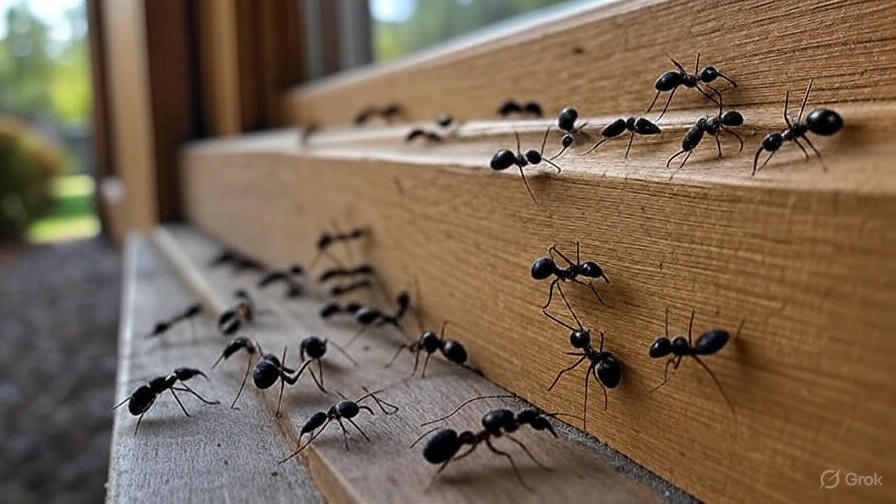How to Get Rid of Carpenter Ants?
Carpenter ants invade homes across North America, causing thousands of dollars in structural damage each year. These destructive insects tunnel through wooden structures, creating extensive galleries that weaken your home’s foundation and framework. Unlike termites that actually eat wood, carpenter ants excavate tunnels to build their nests, leaving behind telltale piles of wood shavings called frass.
Most homeowners discover carpenter ant infestations when they notice large black ants wandering around their kitchen or bathroom during nighttime hours. These nocturnal pests prefer moisture-rich environments and often establish satellite colonies in areas with water damage or high humidity levels. The parent colony typically resides outdoors in decaying tree stumps, logs, or wooden structures, while satellite colonies move indoors to exploit food sources and suitable nesting sites.
Identifying Carpenter Ant Infestations in Your Home
Carpenter ants measure between 6 to 13 millimeters in length, making them among the largest ant species found in residential settings. Workers display solid black coloration, though some species exhibit reddish-brown hues or combinations of both colors. Their segmented bodies feature a narrow waist between the thorax and abdomen, with elbowed antennae that help distinguish them from other ant species.
The most obvious sign of carpenter ant activity involves discovering wood shavings beneath wooden structures. These insects create clean, smooth tunnels with sandpaper-like surfaces, leaving behind coarse sawdust mixed with insect body parts and food debris. Fresh frass appears light-colored and feels dry to the touch, while older accumulations turn darker and may contain moisture.
Homeowners often hear faint rustling sounds within walls, especially during quiet evening hours when carpenter ants become most active. These sounds result from workers excavating new tunnels or moving through existing galleries. Tapping wooden surfaces may produce hollow sounds in areas where extensive tunneling has occurred.
Winged reproductive ants, called alates, emerge from mature colonies during spring and early summer months. Finding these winged insects indoors indicates an established colony nearby, as reproductive ants only develop in colonies that have existed for several years. Dead winged ants near windows or light fixtures suggest an indoor nesting site.
Locating Carpenter Ant Nests and Entry Points
Successful carpenter ant elimination requires locating both the parent colony and any satellite colonies established within your home. Parent colonies typically exist outdoors in dead tree stumps, fallen logs, or wooden structures like decks and sheds. These colonies can house thousands of individuals and serve as the source for satellite colonies that invade indoor spaces.
Satellite colonies develop in areas with consistent moisture, such as bathrooms, kitchens, basements, and areas around leaky pipes or damaged roofing. These smaller colonies focus on food gathering and may contain several hundred workers along with developing larvae and pupae.
Follow ant trails during evening hours when carpenter ants display peak activity levels. Workers create pheromone trails between food sources and nesting sites, making it easier to track their movement patterns. Common entry points include cracks in foundations, gaps around windows and doors, openings where utility lines enter the home, and damaged weather stripping.
Inspect areas with previous water damage, as carpenter ants prefer soft, moisture-damaged wood for nest construction. Check around dishwashers, washing machines, water heaters, and areas beneath leaky roofs. Wood that sounds hollow when tapped may contain carpenter ant tunnels.
Use a flashlight to examine dark spaces like crawl spaces, basements, and attics where carpenter ants often establish satellite colonies. Look for frass accumulations, which typically appear near nest entrances or in areas directly below active galleries.
Natural Methods for Carpenter Ant Control
Several natural approaches can effectively eliminate carpenter ant colonies without introducing synthetic chemicals into your living environment. These methods work best when combined with proper identification and targeted application at nest sites and along ant trails.
Diatomaceous earth provides an effective natural treatment for carpenter ant infestations. This fine powder consists of fossilized algae that damages ant exoskeletons, causing dehydration and death. Apply food-grade diatomaceous earth along ant trails, around entry points, and in areas where you suspect nesting activity. The powder remains effective until it becomes wet, so reapply after cleaning or exposure to moisture.
Borax-based bait stations offer another natural solution for carpenter ant control. Mix equal parts borax and sugar to create an attractive yet lethal bait. Place small amounts in bottle caps or shallow dishes near ant trails and suspected nest sites. Workers carry the bait back to their colonies, where it eliminates other colony members through food sharing. Keep borax baits away from children and pets, as this substance can cause harm if ingested.
Coffee grounds deter carpenter ants due to their strong scent and acidic properties. Sprinkle used coffee grounds around entry points, along ant trails, and in areas where you’ve observed ant activity. Refresh the grounds every few days to maintain their effectiveness.
Cinnamon essential oil disrupts carpenter ant pheromone trails and creates an unpleasant environment for these insects. Mix 10-15 drops of cinnamon oil with one cup of water in a spray bottle. Apply this solution to ant trails, entry points, and areas around suspected nesting sites. The strong scent masks pheromone trails that guide worker ants between food sources and their colonies.
White vinegar eliminates existing pheromone trails and creates an acidic environment that carpenter ants avoid. Mix equal parts water and white vinegar in a spray bottle and apply to ant trails and entry points. The vinegar evaporates quickly, so reapply daily for best results.
Chemical Treatment Options for Severe Infestations
When natural methods fail to eliminate carpenter ant colonies, chemical treatments provide more aggressive control options. Professional-grade insecticides offer faster results and longer-lasting protection against reinfestation.
Ant baits containing fipronil or hydramethylnon provide effective colony elimination by targeting worker ants that carry poison back to their nests. These slow-acting insecticides allow workers to return to their colonies before dying, ensuring the poison reaches larvae, pupae, and reproductive ants. Place bait stations along ant trails and near suspected nest sites, replacing them every few weeks until ant activity ceases.
Liquid insecticides create barrier treatments that prevent carpenter ants from entering your home while eliminating existing colonies. Products containing bifenthrin or permethrin provide long-lasting residual protection when applied to entry points, foundation perimeters, and areas around windows and doors. These treatments typically remain effective for several months with proper application.
Dust insecticides work well for treating wall voids and other enclosed spaces where carpenter ants establish satellite colonies. Boric acid dust or synthetic insecticide powders can be applied through small holes drilled into wall voids, providing direct contact with nesting sites. Professional pest control technicians often use specialized equipment to apply dust treatments in hard-to-reach areas.
Injectable foam insecticides expand to fill wall voids and other hollow spaces where carpenter ants create galleries. These products provide immediate knockdown of visible ants while delivering residual protection against future invasions. The foam expands to contact hidden nest sites that other treatments might miss.
Professional Pest Control Services
Complex carpenter ant infestations often require professional intervention, especially when multiple colonies exist or when structural damage has occurred. Pest control professionals possess specialized knowledge, equipment, and access to restricted-use pesticides that provide more effective treatment options.
Professional technicians conduct thorough inspections to identify all colony locations, entry points, and contributing factors that support carpenter ant populations. They use moisture meters to detect hidden water damage, borescopes to examine wall voids, and other diagnostic tools that help locate hidden nesting sites.
Integrated pest management approaches combine multiple treatment methods for comprehensive carpenter ant control. Professional services typically include liquid barrier treatments, targeted baiting programs, dust applications in wall voids, and ongoing monitoring to ensure complete colony elimination.
Many pest control companies offer warranties or guarantee periods for their carpenter ant treatments, providing peace of mind and follow-up services if ant activity returns. These service agreements often include regular inspections and preventive treatments to maintain long-term protection.
Professional treatments prove most cost-effective for severe infestations or when previous DIY efforts have failed. The expertise and specialized equipment available through professional services often achieve faster results with fewer repeat applications.
Prevention Strategies to Keep Carpenter Ants Away
Preventing carpenter ant infestations requires eliminating the conditions that attract these pests to your property. Most prevention efforts focus on moisture control, structural maintenance, and reducing food sources that support ant populations.
Repair all sources of moisture infiltration, including leaky pipes, damaged roofing, clogged gutters, and poor drainage around your home’s foundation. Carpenter ants require consistent moisture for colony development, so eliminating water sources makes your property less attractive to these pests.
Maintain proper ventilation in basements, crawl spaces, and attics to reduce humidity levels that encourage carpenter ant nesting. Install exhaust fans in bathrooms and kitchens to remove excess moisture from daily activities. Use dehumidifiers in problematic areas where moisture levels remain consistently high.
Trim tree branches and shrubs away from your home’s exterior to eliminate bridges that carpenter ants use to access your property. Remove dead trees, stumps, and decaying wood from your landscape, as these materials provide ideal nesting sites for parent colonies.
Seal cracks and gaps around windows, doors, and foundation walls using caulk or weatherstripping. Install door sweeps and repair damaged screens to prevent ant entry. Pay special attention to areas where utility lines enter your home, as these openings often provide easy access routes.
Store firewood at least 20 feet away from your home and elevate it off the ground using concrete blocks or metal stands. Inspect lumber and other wooden materials before bringing them indoors, as carpenter ants may have established colonies in these items.
Clean up food spills immediately and store pantry items in sealed containers. While carpenter ants prefer protein sources, they also feed on sweet substances and pet food that can sustain colony populations near your home.
Long-Term Monitoring and Maintenance
Successful carpenter ant control requires ongoing vigilance and regular maintenance to prevent reinfestation. Establish a monitoring routine that includes regular inspections of vulnerable areas and maintenance of preventive measures.
Inspect your home’s exterior monthly for signs of carpenter ant activity, paying special attention to areas with previous infestations. Look for new frass accumulations, ant trails, and structural damage that might indicate renewed activity. Early detection allows for prompt treatment before colonies become established.
Schedule annual professional inspections if you’ve experienced previous carpenter ant problems or if your property contains risk factors like moisture issues or extensive wooden structures. Professional technicians can identify subtle signs of activity that homeowners might miss and provide preventive treatments when necessary.
Maintain moisture control systems including dehumidifiers, exhaust fans, and drainage improvements. Replace weatherstripping and caulk as needed to maintain effective barriers against ant entry. Address new moisture issues promptly to prevent conditions that attract carpenter ants.
Document any ant activity you observe, including locations, times, and treatment methods used. This information helps track the effectiveness of your control efforts and provides valuable data for pest control professionals if their services become necessary.
Conclusion
Carpenter ant control requires a comprehensive approach that combines proper identification, targeted treatment, and ongoing prevention efforts. Success depends on locating all colony sites, eliminating moisture sources, and maintaining barriers against future invasions.
Natural treatment methods work well for minor infestations and as part of integrated control programs. Chemical treatments provide faster results for severe infestations, while professional services offer specialized expertise and equipment for complex situations.
Prevention remains the most effective long-term strategy for carpenter ant control. Regular maintenance, moisture control, and structural improvements create an environment that discourages carpenter ant colonization while protecting your home’s structural integrity.
Remember that carpenter ant elimination often requires patience and persistence. Complete colony elimination may take several weeks or months, depending on the infestation size and treatment methods used. Consistent application of control measures and ongoing monitoring ensure lasting protection against these destructive pests.







